Unit 2 Lessons in life 课件(共37张,内嵌音频)_高二英语外研版(2019)选择性必修第四册教材习题精讲
文档属性
| 名称 | Unit 2 Lessons in life 课件(共37张,内嵌音频)_高二英语外研版(2019)选择性必修第四册教材习题精讲 | 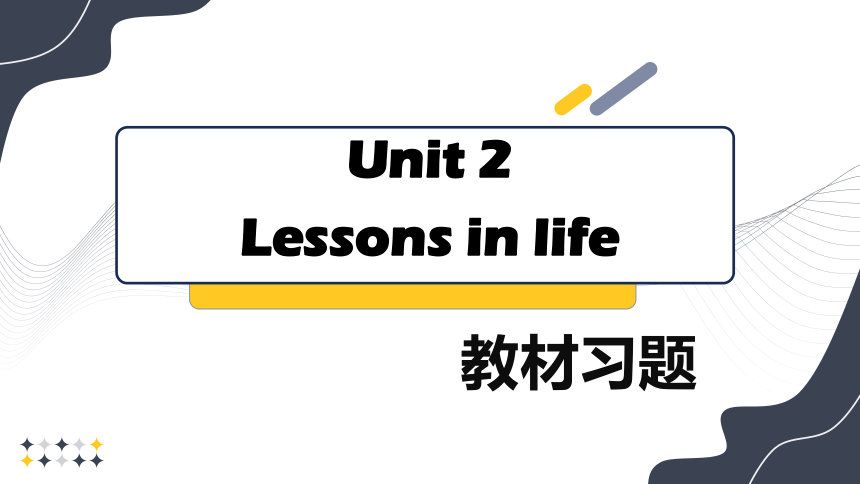 | |
| 格式 | pptx | ||
| 文件大小 | 7.9MB | ||
| 资源类型 | 教案 | ||
| 版本资源 | 外研版(2019) | ||
| 科目 | 英语 | ||
| 更新时间 | 2025-04-21 19:44:22 | ||
图片预览


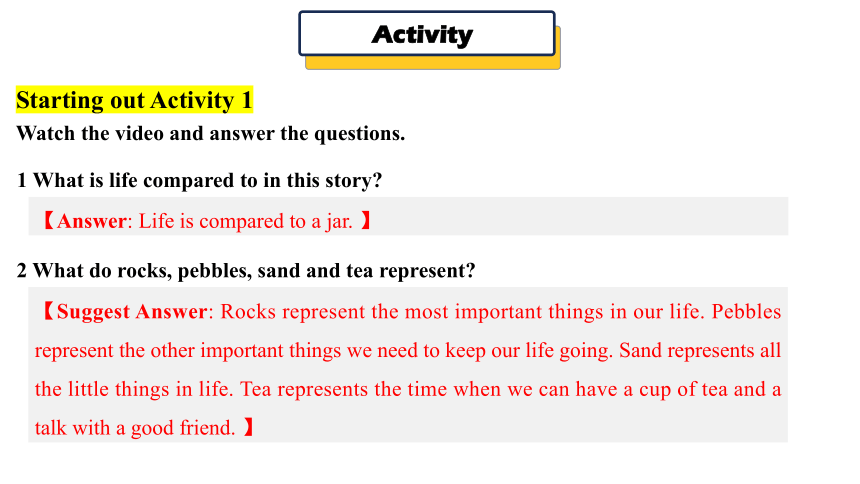
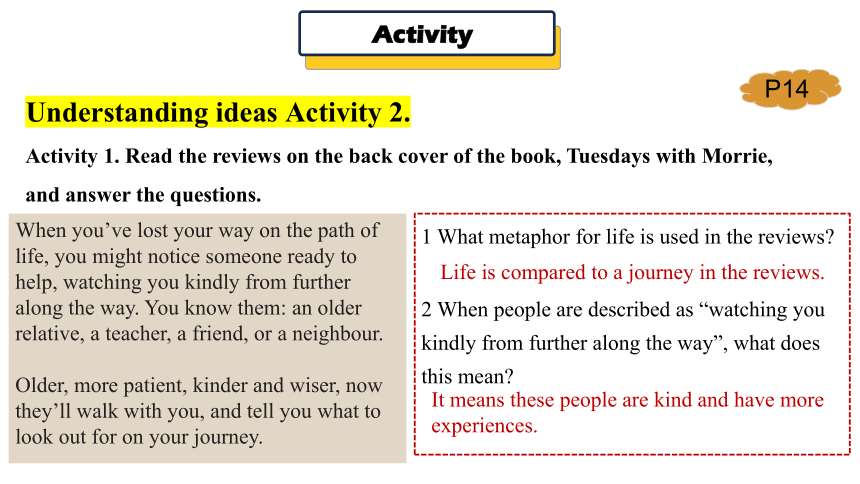
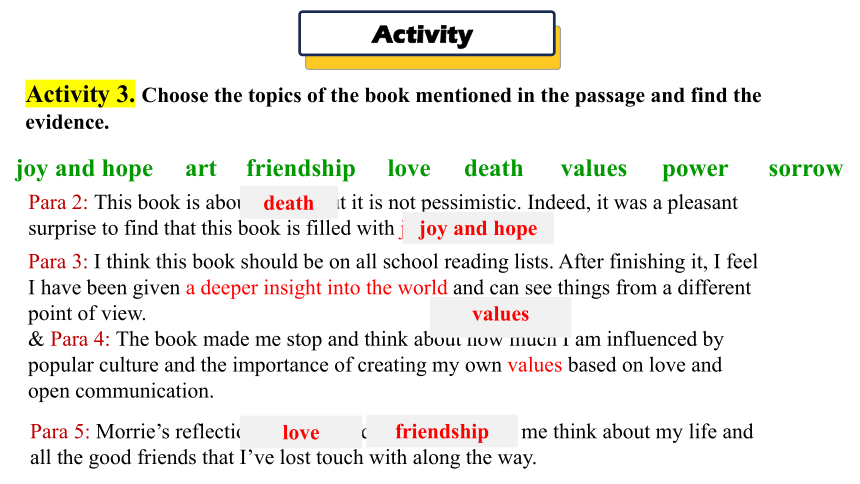
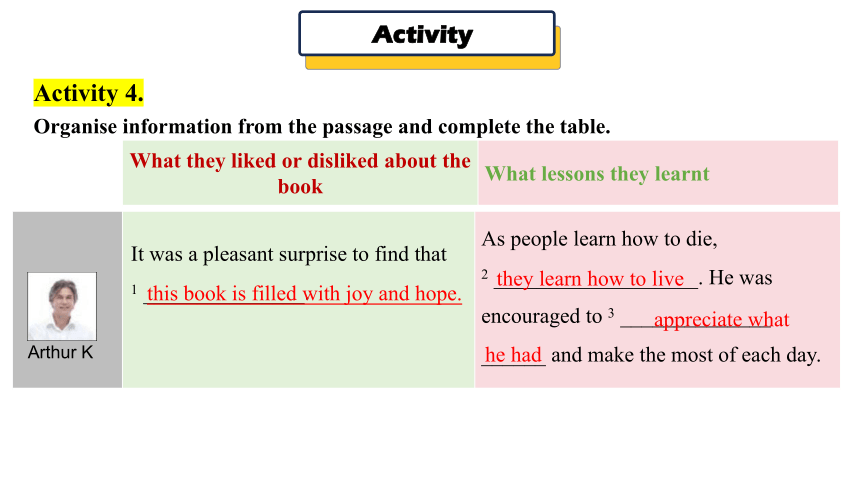

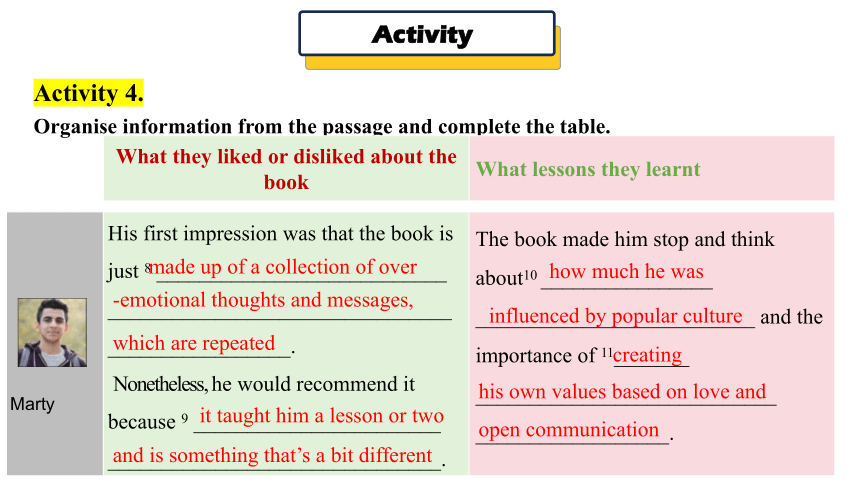

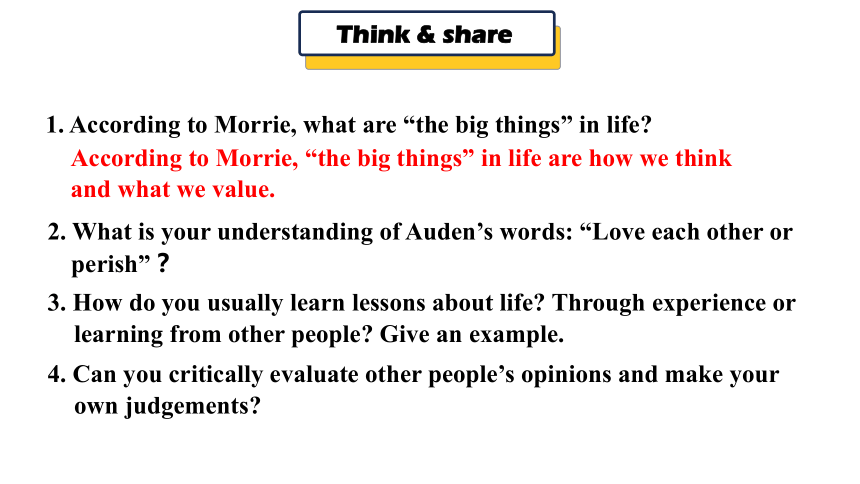
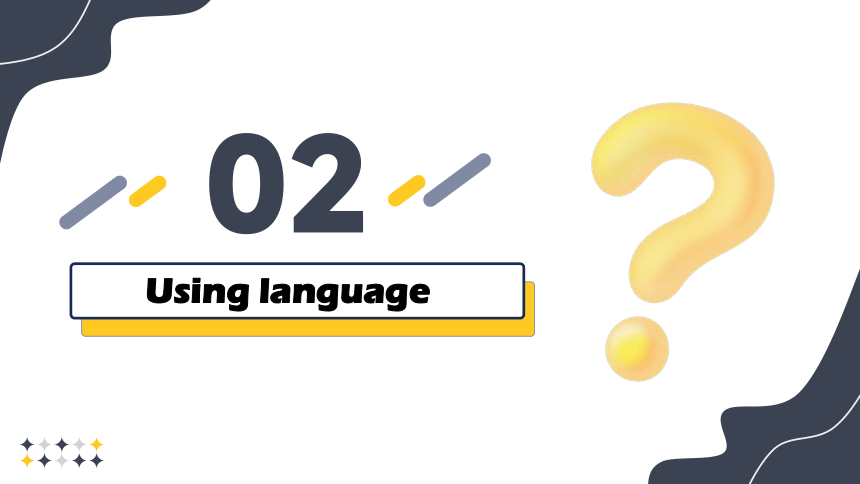

文档简介
(共37张PPT)
教材习题
Unit 2
Lessons in life
01
Understanding ideas
Starting out Activity 1
Watch the video and answer the questions.
Activity
1 What is life compared to in this story
【Answer: Life is compared to a jar. 】
2 What do rocks, pebbles, sand and tea represent
【Suggest Answer: Rocks represent the most important things in our life. Pebbles represent the other important things we need to keep our life going. Sand represents all the little things in life. Tea represents the time when we can have a cup of tea and a talk with a good friend. 】
Understanding ideas Activity 2.
Activity 1. Read the reviews on the back cover of the book, Tuesdays with Morrie, and answer the questions.
Activity
When you’ve lost your way on the path of life, you might notice someone ready to help, watching you kindly from further along the way. You know them: an older relative, a teacher, a friend, or a neighbour.
Older, more patient, kinder and wiser, now they’ll walk with you, and tell you what to look out for on your journey.
1 What metaphor for life is used in the reviews
2 When people are described as “watching you kindly from further along the way”, what does this mean
It means these people are kind and have more experiences.
P14
Life is compared to a journey in the reviews.
Activity 3. Choose the topics of the book mentioned in the passage and find the evidence.
Activity
power
joy and hope
art
friendship
love
death
values
sorrow
Para 2: This book is about dying, but it is not pessimistic. Indeed, it was a pleasant surprise to find that this book is filled with joy and hope.
Para 3: I think this book should be on all school reading lists. After finishing it, I feel I have been given a deeper insight into the world and can see things from a different point of view.
& Para 4: The book made me stop and think about how much I am influenced by popular culture and the importance of creating my own values based on love and open communication.
Para 5: Morrie’s reflections on love and friendship made me think about my life and all the good friends that I’ve lost touch with along the way.
death
joy and hope
values
love
friendship
Activity 4.
Organise information from the passage and complete the table.
Activity
What they liked or disliked about the book What lessons they learnt
As people learn how to die,
2 ___________________. He was encouraged to 3 ______________
______ and make the most of each day.
It was a pleasant surprise to find that 1 _______________.
this book is filled with joy and hope.
they learn how to live
appreciate what
he had
Arthur K
Activity 4.
Organise information from the passage and complete the table.
Activity
What they liked or disliked about the book What lessons they learnt
She thinks the book should be on 4 ____________________. And she felt she was given 5__________________________.
Amy Wang
all school reading lists
a deeper insight into the world
People should choose 6 ________
___________________ themselves. She felt as if she had been woken up from a long sleep and finally 7__________________________.
think, what they value
how they
opened her eyes to the world
Activity 4.
Organise information from the passage and complete the table.
Activity
What they liked or disliked about the book What lessons they learnt
The book made him stop and think about10 ________________
__________________________ and the importance of 11_______
____________________________
__________________.
His first impression was that the book is just 8 ___________________________
_________________________________________________.
Nonetheless, he would recommend it because 9 _______________________
_______________________________.
Marty
made up of a collection of over
-emotional thoughts and messages,
which are repeated
it taught him a lesson or two
and is something that’s a bit different
how much he was
influenced by popular culture
creating
his own values based on love and
open communication
Activity 4.
Organise information from the passage and complete the table.
Activity
What they liked or disliked about the book What lessons they learnt
People should always keep in touch 14 ______________________
_________________________. She was aware that people want to 15 ___________________________ ____________, knowing that
16 __________________________.
The book made her cry because Morrie’s reflections on 12 ____ _____________made her think about 13 ____________________
___________________________
________________.
love
her life and all the good
and friendship
friends that she has lost touch
with along the way
with the good people they
meet as they go through life
die feeling that they have lived
life to the full
they are loved and have loved others as much as they could
Vivian
Think & share
1. According to Morrie, what are “the big things” in life
According to Morrie, “the big things” in life are how we think and what we value.
3. How do you usually learn lessons about life Through experience or learning from other people Give an example.
4. Can you critically evaluate other people’s opinions and make your own judgements
2. What is your understanding of Auden’s words: “Love each other or perish”?
02
Using language
Activity
1 The subject is not known, is nimportant, or is “people in general” and can be omitted.
2 The focus of the sentence is on the recipient of the action, not on the subject of the sentence.
3 The subject goes with lengthy expressions that are better put at the end.
c
a
b
Activity 2. Rewrite the paragraph using the passive voice where appropriate.
Activity
Since ancient times, storytelling has been a way to share and pass on wisdom. One important early work that did so was Aesop’s Fables, a collection of stories that history credits to Aesop, a Greek storyteller. People believe that he lived in Ancient Greece between 620 BC and 564 BC. Most of the characters in his stories are animals, the qualities of which Aesop used to reflect human traits and wisdom. Each fable teaches a life lesson that Aesop summarises in a short phrase at the end of the story, called a moral. Today, children and adults all around the world still enjoy Aesop’s Fables.
Activity
Since ancient times, storytelling has been a way to share and pass on wisdom. One important early work that did so was Aesop’s Fables, a collection of stories that is credited to Aesop , a Greek storyteller. It is believed that Aesop lived in Ancient Greece between 620 BC and 564 BC. Most of the characters in his stories are animals, the qualities of which were used to reflect human traits and wisdom by Aesop. Each fable teaches a life lesson that is summarised in a short phrase at the end of the story, called a moral. Today, Aesop’s Fables is still enjoyed by children and adults all around the world.
Activity 2. Rewrite the paragraph using the passive voice where appropriate.
Activity
Activity 3. Look at the pictures and write the story from Aesop’s Fables. Use the passive voice where appropriate.
Activity
Activity 3. Look at the pictures and write the story from Aesop’s Fables. Use the passive voice where appropriate.
A little mouse was caught by a lion.
The mouse was let to go.
Activity
Activity 3. Look at the pictures and write the story from Aesop’s Fables. Use the passive voice where appropriate.
The lion was trapped by a net.
The lion was saved by the mouse.
Activity
Activity 3. Look at the pictures and write the story from Aesop’s Fables. Use the passive voice where appropriate.
One day a little mouse was caught by a lion. The lion wanted to eat the mouse, but the mouse said that he would help the lion someday, if he was let to go. The lion thought, “How can a great animal be helped by a little animal ” But the mouse was allowed to leave. Several days later, the lion was caught by a hunter’s net. The mouse bit the net with his strong teeth and helped the lion out. Thanks to the little mouse, the lion was saved and finally admitted that the strong could sometimes be helped by the weak.
Activity 5. Listen and complete the conversations.
Activity
1 A: Professor Brown, here’s my term paper. Sorry for the delay.
B: That’s OK. ______________________, right?
2 A: Maths is really killing me! I’m thinking of giving it up.
B: ___________________. You’ll never get your dream job as a market
analyst if you don’t stick to it.
3 A: If you want to loose weight, you need to stop eating junk food, and
you need to start exercising.
B: OK. I’ll start tomorrow… maybe.
A: Today. Not tomorrow.
________________________________________________________.
Better late than never
No pain, no gain
Never put off until tomorrow what you can do today
Activity 5. Listen and complete the conversations.
Activity
5 A: With my brother’s help, I finally
completed my biology project!
B: Congratulations.
_____________________________.
6 A: I heard that Mary is going to invest
all her money in this programme.
B: That’s not wise. As people usually
say “ _______________________
______________________________.”
I’ll talk to her as soon as possible.
4 A: I’m glad you finally got
here.
B: My car had a flat tyre on
the way. Anyway,
____________________.
all’s well that ends well
Two heads are better than one
Don’t put all of your eggs in one basket
Activity 6. Match the proverbs in Activity 5 to their meanings.
Activity
1 ______________ ___: you must face challenges in order to be successful.
2 ___________________________: it is easier to achieve something if you cooperate with someone else.
3 ___________________: doing something late is better than not doing it at all.
4 ____________________________________________: you should start things earlier rather than later.
5 __________________________________: do not put all your efforts or resources into doing one thing.
6 _______________________: problems don’t matter if the final result is good.
No pain, no gain.
Two heads are better than one.
Better late than never.
Never put off until tomorrow what you can do today.
Don’t put all of your eggs in one basket.
All’s well that ends well.
Activity 8. Listen to the interview and choose the best headline.
Activity
1 University Fees Are No Barrier to Grandma!
2 Dream Comes True for Graduating Grandma
3 Janet Says: “Family first! That’s what matters!”
4 How the Student Experience Has Changed with the Centuries
√
Activity 9. Listen again and complete the notes.
Activity
Interview with Janet Rose
Age: 1______
First attended university in: 2__________________
Reason for leaving university: 3____________________________________________________________
Reason for going back to university:4_______________________________
_____________________________________________________________
Initial feelings on returning to university:
5____________________________________________________________
University major: 6__________________
Feelings on graduation: 7_________________________________________
Advice to others: 8______________________________________________
Future plans: 9_________________________________________________
81
1955
She took care of her ill mother and helped her father.
Her daughter suggested she go back to
school five years ago and she jumped at the chance.
She felt a bit nervous at first and she felt so old.
American literature.
She feels great.
You’re never too old to learn.
Starting a master’s degree in the fall.
Activity plete the boxes with the expressions from the interview.
Activity
I started... back in ...
After that I ...
But then five years ago ...
I felt... at first.
I suggest that ...
Remember, ...
I started... back in...
After that I...
But then five years ago...
I felt... at first...
Giving advice
Talking about experiences
I suggest that...
Remember,...
03
Developing ideas
Activity 1. Read the introduction to The Blue Bird and answer the questions.
Activity
1. Do you know the symbolic meaning of the Blue Bird in Chinese and Western cultures Share your understanding of the meaning with the class.
In Western culture the Blue Bird symbolizes happiness and it brings good luck and health to people, while in Chinese culture the Blue Bird symbolises the messenger.
Activity 2. Complete the notes with information from the play.
Activity
ACT IV SCENE II
Characters
Setting
Plot
Tyltyl, (Mytyl,) a troop of Happinesses, the (chief) Happiness
Tyltyl and Mytyl have been searching for the Blue Bird in the Land of Memory, the Palace of Night and the Forest. Now they have arrived at the Palace of Happiness. A troop of Happinesses rush into the hall and speak to them.
The children come to the Palace of Happiness and are welcomed by a
troop of Happinesses...
Activity 2. Complete the notes with information from the play.
Activity
ACT IV SCENE II
The children come to the palace of Happiness and are welcomed by a troop of Happinesses. The children do not recognise them, but the Happinesses tell them that they are the only things the children know and they are all around them. Tyltyl wonders whether there are happinesses in his home, and at this, all the Happinesses burst out laughing. The Chief of the Happinesses tell him that his home is filled with Happinesses. The Chief introduces himself to Tyltyl as the Happiness of Being Well, and then introduces him to the other Happinesses: of Pure Air, of Loving One’s Parents, of the Blue Sky and of the Forest. Tyltyl just wants to ask the Happinesses one thing: the whereabouts of the Blue Bird.
Plot
Activity 2. Complete the notes with information from the play.
Activity
ACT VI SCENE II
Characters
Setting
Plot
Tyltyl, (Mytyl,) Mummy Tyl, the neighbour Berlingot, the little girl
Unable to find the Blue Bird anywhere, the children return home. While they are trying to tell their parents about their adventures, their neighbour comes in. She is asking for Tyltyl’s bird for her sick little girl.
The children return home without finding the Blue Bird...
Activity 2. Complete the notes with information from the play.
Activity
ACT VI SCENE II
Plot
The children return home without finding the Blue Bird.
The neighbour Berlingot, a little old woman, enters Tyltyl's home, leaning on a stick.
Berlingot is telling Mummy Tyl that Tyltyl's bird is the one thing that will cure her sick daughter. Tyltyl then sees that his bird is blue - much bluer than when he went away. Tyltyl gives his bird to his neighbour.
The little girl comes along and thanks Tyltyl, but as lyityl goes to take the bird to show the little girl how to feed him, the bird flies away.
The little girl lets out a cry of despair. Tyltyl comforts her and turns to the audience. He asks the audience to return the Blue Bird if they see him, for the bird is needed for their future happiness.
Think & share
1. Why cannot Tyltyl recognise any of the Happinesses
Because he doesn’t realise the fact that the Happinesses are all around him in his home.
2. Are there any Happiness in your home What are they
3. What does the author want to express by making the Blue Bird fly away at the end of the play
4. What different life lessons can you learn from the two reading passages in this unit
Activity 4. Read the summary of The Blue Bird and answer the questions.
Activity
1. Which paragraph introduces the main charaters, setting and start of the play.
Paragraph one.
The Blue Bird is a six-act fairy play written by Maurice Maeterlinck. It’s a story about Tyltyl and Mytyl’s adventures as they search for the Blue Bird of Happiness. As the children of a poor woodcutter, they are secretly observing a party at the home of their wealthy landlords when a fairy appears. She uses a magic diamond to bring animals (their dog and cat), objects (sugar and bread) and elements (light, fire, water) in their home to life. Together, they set off on a dangerous journey in search of the Blue Bird.
Activity 4. Read the summary of The Blue Bird and answer the questions.
Activity
2. What is the climax of the play
The play’s climax of the play happens when Tyltyl discovers the Blue Bird has been there in his home all the time.
Tyltyl and Mytyl go to many magical places. They encounter numerous characters such as their departed grandparents, trees that hate mankind, the greedy and ugly Luxuries, and children waiting to be born. Although they try very hard to find the Blue Bird, the birds they find either change colour or die. The children return home at last, and Tyltyl discovers the Blue Bird has been there all the time! He gives the bird to the neighbour’s little girl, curing her illness.
Activity 4. Read the summary of The Blue Bird and answer the questions.
Activity
The theme of the play is that happiness is to be found not in luxuries, but in simple things, such as family life, acts of friendship and kindness.
But in the end, the bird flies away, and Tyltyl asks the audience to search for it.
The central idea of the play is that happiness is to be found not in luxuries such
as wealth, but in simple things that are found in family life, and in acts of friendship and kindness.
3. What is the theme of the play
【Sample】
The Merchant of Venice is one of Shakespeare’s plays. Bassanio, a noble but penniless Venetian, asks his friend Antonio for a loan so that Bassanio can undertake a journey to woo Portia. Antonio, whose money is invested in foreign ventures, borrows money from Shylock in order to be able to assist Bassanio. However, if the loan cannot be repaid in time, Antonio will give Shylock a pound of flesh.
Activity
【Sample】
News arrives that Antonio’s ships have been lost at sea. Unable to get his money back, Shylock attempts to use justice to enforce a terrible revenge on Antonio: he demands his pound of flesh. Shylock’s revengeful plan is foiled by Portia, who turns the tables on Shylock by an argument: he must take flesh only, and Shylock must die if any blood is spilled. Thus, the contract is cancelled. The play ends with the news that, in fact, some of Antonio’s ships have arrived safely.
This play, in my opinion, focuses on several main themes, such as the strong friendship between Bassanio and Antonio, the strength of women’s character of overcoming the restraints set by society of that time, and so on.
Activity
THANKS
教材习题
Unit 2
Lessons in life
01
Understanding ideas
Starting out Activity 1
Watch the video and answer the questions.
Activity
1 What is life compared to in this story
【Answer: Life is compared to a jar. 】
2 What do rocks, pebbles, sand and tea represent
【Suggest Answer: Rocks represent the most important things in our life. Pebbles represent the other important things we need to keep our life going. Sand represents all the little things in life. Tea represents the time when we can have a cup of tea and a talk with a good friend. 】
Understanding ideas Activity 2.
Activity 1. Read the reviews on the back cover of the book, Tuesdays with Morrie, and answer the questions.
Activity
When you’ve lost your way on the path of life, you might notice someone ready to help, watching you kindly from further along the way. You know them: an older relative, a teacher, a friend, or a neighbour.
Older, more patient, kinder and wiser, now they’ll walk with you, and tell you what to look out for on your journey.
1 What metaphor for life is used in the reviews
2 When people are described as “watching you kindly from further along the way”, what does this mean
It means these people are kind and have more experiences.
P14
Life is compared to a journey in the reviews.
Activity 3. Choose the topics of the book mentioned in the passage and find the evidence.
Activity
power
joy and hope
art
friendship
love
death
values
sorrow
Para 2: This book is about dying, but it is not pessimistic. Indeed, it was a pleasant surprise to find that this book is filled with joy and hope.
Para 3: I think this book should be on all school reading lists. After finishing it, I feel I have been given a deeper insight into the world and can see things from a different point of view.
& Para 4: The book made me stop and think about how much I am influenced by popular culture and the importance of creating my own values based on love and open communication.
Para 5: Morrie’s reflections on love and friendship made me think about my life and all the good friends that I’ve lost touch with along the way.
death
joy and hope
values
love
friendship
Activity 4.
Organise information from the passage and complete the table.
Activity
What they liked or disliked about the book What lessons they learnt
As people learn how to die,
2 ___________________. He was encouraged to 3 ______________
______ and make the most of each day.
It was a pleasant surprise to find that 1 _______________.
this book is filled with joy and hope.
they learn how to live
appreciate what
he had
Arthur K
Activity 4.
Organise information from the passage and complete the table.
Activity
What they liked or disliked about the book What lessons they learnt
She thinks the book should be on 4 ____________________. And she felt she was given 5__________________________.
Amy Wang
all school reading lists
a deeper insight into the world
People should choose 6 ________
___________________ themselves. She felt as if she had been woken up from a long sleep and finally 7__________________________.
think, what they value
how they
opened her eyes to the world
Activity 4.
Organise information from the passage and complete the table.
Activity
What they liked or disliked about the book What lessons they learnt
The book made him stop and think about10 ________________
__________________________ and the importance of 11_______
____________________________
__________________.
His first impression was that the book is just 8 ___________________________
_________________________________________________.
Nonetheless, he would recommend it because 9 _______________________
_______________________________.
Marty
made up of a collection of over
-emotional thoughts and messages,
which are repeated
it taught him a lesson or two
and is something that’s a bit different
how much he was
influenced by popular culture
creating
his own values based on love and
open communication
Activity 4.
Organise information from the passage and complete the table.
Activity
What they liked or disliked about the book What lessons they learnt
People should always keep in touch 14 ______________________
_________________________. She was aware that people want to 15 ___________________________ ____________, knowing that
16 __________________________.
The book made her cry because Morrie’s reflections on 12 ____ _____________made her think about 13 ____________________
___________________________
________________.
love
her life and all the good
and friendship
friends that she has lost touch
with along the way
with the good people they
meet as they go through life
die feeling that they have lived
life to the full
they are loved and have loved others as much as they could
Vivian
Think & share
1. According to Morrie, what are “the big things” in life
According to Morrie, “the big things” in life are how we think and what we value.
3. How do you usually learn lessons about life Through experience or learning from other people Give an example.
4. Can you critically evaluate other people’s opinions and make your own judgements
2. What is your understanding of Auden’s words: “Love each other or perish”?
02
Using language
Activity
1 The subject is not known, is nimportant, or is “people in general” and can be omitted.
2 The focus of the sentence is on the recipient of the action, not on the subject of the sentence.
3 The subject goes with lengthy expressions that are better put at the end.
c
a
b
Activity 2. Rewrite the paragraph using the passive voice where appropriate.
Activity
Since ancient times, storytelling has been a way to share and pass on wisdom. One important early work that did so was Aesop’s Fables, a collection of stories that history credits to Aesop, a Greek storyteller. People believe that he lived in Ancient Greece between 620 BC and 564 BC. Most of the characters in his stories are animals, the qualities of which Aesop used to reflect human traits and wisdom. Each fable teaches a life lesson that Aesop summarises in a short phrase at the end of the story, called a moral. Today, children and adults all around the world still enjoy Aesop’s Fables.
Activity
Since ancient times, storytelling has been a way to share and pass on wisdom. One important early work that did so was Aesop’s Fables, a collection of stories that is credited to Aesop , a Greek storyteller. It is believed that Aesop lived in Ancient Greece between 620 BC and 564 BC. Most of the characters in his stories are animals, the qualities of which were used to reflect human traits and wisdom by Aesop. Each fable teaches a life lesson that is summarised in a short phrase at the end of the story, called a moral. Today, Aesop’s Fables is still enjoyed by children and adults all around the world.
Activity 2. Rewrite the paragraph using the passive voice where appropriate.
Activity
Activity 3. Look at the pictures and write the story from Aesop’s Fables. Use the passive voice where appropriate.
Activity
Activity 3. Look at the pictures and write the story from Aesop’s Fables. Use the passive voice where appropriate.
A little mouse was caught by a lion.
The mouse was let to go.
Activity
Activity 3. Look at the pictures and write the story from Aesop’s Fables. Use the passive voice where appropriate.
The lion was trapped by a net.
The lion was saved by the mouse.
Activity
Activity 3. Look at the pictures and write the story from Aesop’s Fables. Use the passive voice where appropriate.
One day a little mouse was caught by a lion. The lion wanted to eat the mouse, but the mouse said that he would help the lion someday, if he was let to go. The lion thought, “How can a great animal be helped by a little animal ” But the mouse was allowed to leave. Several days later, the lion was caught by a hunter’s net. The mouse bit the net with his strong teeth and helped the lion out. Thanks to the little mouse, the lion was saved and finally admitted that the strong could sometimes be helped by the weak.
Activity 5. Listen and complete the conversations.
Activity
1 A: Professor Brown, here’s my term paper. Sorry for the delay.
B: That’s OK. ______________________, right?
2 A: Maths is really killing me! I’m thinking of giving it up.
B: ___________________. You’ll never get your dream job as a market
analyst if you don’t stick to it.
3 A: If you want to loose weight, you need to stop eating junk food, and
you need to start exercising.
B: OK. I’ll start tomorrow… maybe.
A: Today. Not tomorrow.
________________________________________________________.
Better late than never
No pain, no gain
Never put off until tomorrow what you can do today
Activity 5. Listen and complete the conversations.
Activity
5 A: With my brother’s help, I finally
completed my biology project!
B: Congratulations.
_____________________________.
6 A: I heard that Mary is going to invest
all her money in this programme.
B: That’s not wise. As people usually
say “ _______________________
______________________________.”
I’ll talk to her as soon as possible.
4 A: I’m glad you finally got
here.
B: My car had a flat tyre on
the way. Anyway,
____________________.
all’s well that ends well
Two heads are better than one
Don’t put all of your eggs in one basket
Activity 6. Match the proverbs in Activity 5 to their meanings.
Activity
1 ______________ ___: you must face challenges in order to be successful.
2 ___________________________: it is easier to achieve something if you cooperate with someone else.
3 ___________________: doing something late is better than not doing it at all.
4 ____________________________________________: you should start things earlier rather than later.
5 __________________________________: do not put all your efforts or resources into doing one thing.
6 _______________________: problems don’t matter if the final result is good.
No pain, no gain.
Two heads are better than one.
Better late than never.
Never put off until tomorrow what you can do today.
Don’t put all of your eggs in one basket.
All’s well that ends well.
Activity 8. Listen to the interview and choose the best headline.
Activity
1 University Fees Are No Barrier to Grandma!
2 Dream Comes True for Graduating Grandma
3 Janet Says: “Family first! That’s what matters!”
4 How the Student Experience Has Changed with the Centuries
√
Activity 9. Listen again and complete the notes.
Activity
Interview with Janet Rose
Age: 1______
First attended university in: 2__________________
Reason for leaving university: 3____________________________________________________________
Reason for going back to university:4_______________________________
_____________________________________________________________
Initial feelings on returning to university:
5____________________________________________________________
University major: 6__________________
Feelings on graduation: 7_________________________________________
Advice to others: 8______________________________________________
Future plans: 9_________________________________________________
81
1955
She took care of her ill mother and helped her father.
Her daughter suggested she go back to
school five years ago and she jumped at the chance.
She felt a bit nervous at first and she felt so old.
American literature.
She feels great.
You’re never too old to learn.
Starting a master’s degree in the fall.
Activity plete the boxes with the expressions from the interview.
Activity
I started... back in ...
After that I ...
But then five years ago ...
I felt... at first.
I suggest that ...
Remember, ...
I started... back in...
After that I...
But then five years ago...
I felt... at first...
Giving advice
Talking about experiences
I suggest that...
Remember,...
03
Developing ideas
Activity 1. Read the introduction to The Blue Bird and answer the questions.
Activity
1. Do you know the symbolic meaning of the Blue Bird in Chinese and Western cultures Share your understanding of the meaning with the class.
In Western culture the Blue Bird symbolizes happiness and it brings good luck and health to people, while in Chinese culture the Blue Bird symbolises the messenger.
Activity 2. Complete the notes with information from the play.
Activity
ACT IV SCENE II
Characters
Setting
Plot
Tyltyl, (Mytyl,) a troop of Happinesses, the (chief) Happiness
Tyltyl and Mytyl have been searching for the Blue Bird in the Land of Memory, the Palace of Night and the Forest. Now they have arrived at the Palace of Happiness. A troop of Happinesses rush into the hall and speak to them.
The children come to the Palace of Happiness and are welcomed by a
troop of Happinesses...
Activity 2. Complete the notes with information from the play.
Activity
ACT IV SCENE II
The children come to the palace of Happiness and are welcomed by a troop of Happinesses. The children do not recognise them, but the Happinesses tell them that they are the only things the children know and they are all around them. Tyltyl wonders whether there are happinesses in his home, and at this, all the Happinesses burst out laughing. The Chief of the Happinesses tell him that his home is filled with Happinesses. The Chief introduces himself to Tyltyl as the Happiness of Being Well, and then introduces him to the other Happinesses: of Pure Air, of Loving One’s Parents, of the Blue Sky and of the Forest. Tyltyl just wants to ask the Happinesses one thing: the whereabouts of the Blue Bird.
Plot
Activity 2. Complete the notes with information from the play.
Activity
ACT VI SCENE II
Characters
Setting
Plot
Tyltyl, (Mytyl,) Mummy Tyl, the neighbour Berlingot, the little girl
Unable to find the Blue Bird anywhere, the children return home. While they are trying to tell their parents about their adventures, their neighbour comes in. She is asking for Tyltyl’s bird for her sick little girl.
The children return home without finding the Blue Bird...
Activity 2. Complete the notes with information from the play.
Activity
ACT VI SCENE II
Plot
The children return home without finding the Blue Bird.
The neighbour Berlingot, a little old woman, enters Tyltyl's home, leaning on a stick.
Berlingot is telling Mummy Tyl that Tyltyl's bird is the one thing that will cure her sick daughter. Tyltyl then sees that his bird is blue - much bluer than when he went away. Tyltyl gives his bird to his neighbour.
The little girl comes along and thanks Tyltyl, but as lyityl goes to take the bird to show the little girl how to feed him, the bird flies away.
The little girl lets out a cry of despair. Tyltyl comforts her and turns to the audience. He asks the audience to return the Blue Bird if they see him, for the bird is needed for their future happiness.
Think & share
1. Why cannot Tyltyl recognise any of the Happinesses
Because he doesn’t realise the fact that the Happinesses are all around him in his home.
2. Are there any Happiness in your home What are they
3. What does the author want to express by making the Blue Bird fly away at the end of the play
4. What different life lessons can you learn from the two reading passages in this unit
Activity 4. Read the summary of The Blue Bird and answer the questions.
Activity
1. Which paragraph introduces the main charaters, setting and start of the play.
Paragraph one.
The Blue Bird is a six-act fairy play written by Maurice Maeterlinck. It’s a story about Tyltyl and Mytyl’s adventures as they search for the Blue Bird of Happiness. As the children of a poor woodcutter, they are secretly observing a party at the home of their wealthy landlords when a fairy appears. She uses a magic diamond to bring animals (their dog and cat), objects (sugar and bread) and elements (light, fire, water) in their home to life. Together, they set off on a dangerous journey in search of the Blue Bird.
Activity 4. Read the summary of The Blue Bird and answer the questions.
Activity
2. What is the climax of the play
The play’s climax of the play happens when Tyltyl discovers the Blue Bird has been there in his home all the time.
Tyltyl and Mytyl go to many magical places. They encounter numerous characters such as their departed grandparents, trees that hate mankind, the greedy and ugly Luxuries, and children waiting to be born. Although they try very hard to find the Blue Bird, the birds they find either change colour or die. The children return home at last, and Tyltyl discovers the Blue Bird has been there all the time! He gives the bird to the neighbour’s little girl, curing her illness.
Activity 4. Read the summary of The Blue Bird and answer the questions.
Activity
The theme of the play is that happiness is to be found not in luxuries, but in simple things, such as family life, acts of friendship and kindness.
But in the end, the bird flies away, and Tyltyl asks the audience to search for it.
The central idea of the play is that happiness is to be found not in luxuries such
as wealth, but in simple things that are found in family life, and in acts of friendship and kindness.
3. What is the theme of the play
【Sample】
The Merchant of Venice is one of Shakespeare’s plays. Bassanio, a noble but penniless Venetian, asks his friend Antonio for a loan so that Bassanio can undertake a journey to woo Portia. Antonio, whose money is invested in foreign ventures, borrows money from Shylock in order to be able to assist Bassanio. However, if the loan cannot be repaid in time, Antonio will give Shylock a pound of flesh.
Activity
【Sample】
News arrives that Antonio’s ships have been lost at sea. Unable to get his money back, Shylock attempts to use justice to enforce a terrible revenge on Antonio: he demands his pound of flesh. Shylock’s revengeful plan is foiled by Portia, who turns the tables on Shylock by an argument: he must take flesh only, and Shylock must die if any blood is spilled. Thus, the contract is cancelled. The play ends with the news that, in fact, some of Antonio’s ships have arrived safely.
This play, in my opinion, focuses on several main themes, such as the strong friendship between Bassanio and Antonio, the strength of women’s character of overcoming the restraints set by society of that time, and so on.
Activity
THANKS
